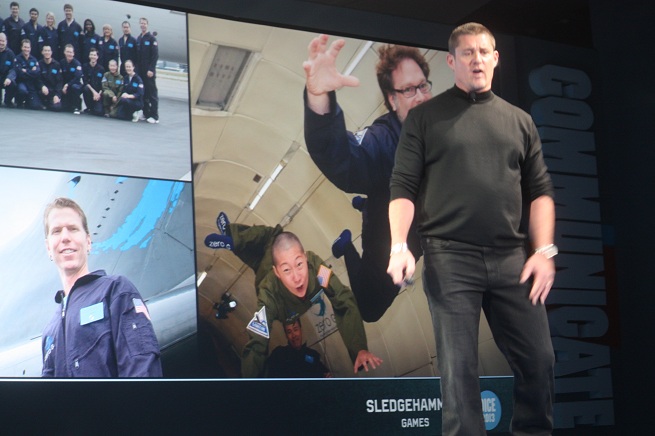LAS VEGAS — Sledgehammer Games general manager Glen Schofield looks everywhere for inspiration for video games he has made (such as Dead Space or Call of Duty: Modern Warfare 3). Schofield, whose studio is owned by Activision, says that you have to keep an open mind and do a wide volume of research to come up with the ideas that will help developers tell a fantastic story in games.
[aditude-amp id="flyingcarpet" targeting='{"env":"staging","page_type":"article","post_id":618001,"post_type":"story","post_chan":"none","tags":null,"ai":false,"category":"none","all_categories":"games,","session":"D"}']“For me, inspiration is a process,” he said in a talk at the DICE Summit, an elite game industry conference in Las Vegas. “Go deep. Keep your mind open. You will be really surprised what you let in when you do.”
Schofield said keeping an open mind is critical at the beginning of any project. So is doing research, going deep into a topic that might seem like a tangent but is critical to putting ideas in your head.
While at EA, Schofield’s team made the space horror game Dead Space. For that, he looked at all sorts of blogs and torture sites. And he talked to horror film director Wes Craven for four or five hours. He happened to hear the sound of a Bay Area Rapid Transit train one day and decided to put that into the game. The sound of the train became the sound of a whirring mechanism inside a part of the space station.
Schofield also suggested that people read widely and see lots of movies. For a helicopter sequence in Modern Warfare 3, he watched the chopper scenes frpm Apocalypse Now and Black Hawk Down over and over.
He also sends teams around to experience combat situations, as much as possible. When he pulled open the door of a Humvee troop carrier, he was astounded that the door was so heavy — maybe 150 pounds. In the opening scene of Modern Warfare 3, a soldier struggles to push open the door of an overturned Humvee, only to see a bunch of debris falling down from the sky around him.
[aditude-amp id="medium1" targeting='{"env":"staging","page_type":"article","post_id":618001,"post_type":"story","post_chan":"none","tags":null,"ai":false,"category":"none","all_categories":"games,","session":"D"}']
“It let us frame the scene,” Schofield said. “You get all those details in your game that are correct.”
Another team (pictured right) went to check out the feeling of weightlessness. They used that experience to create a weightless combat scene (pictured above) in an airliner that was about to crash in Modern Warfare 3.
He noted that the opening scene of Star Wars, where a giant Imperial Star Destroyer chases a tiny Rebel corvette, inspired a ship’s movement in one of his games. Gamers may never have noticed the similarity.
He said, “I’m not saying you rip stuff off. You mine for stuff and look for things others have done really well.”
[aditude-amp id="medium2" targeting='{"env":"staging","page_type":"article","post_id":618001,"post_type":"story","post_chan":"none","tags":null,"ai":false,"category":"none","all_categories":"games,","session":"D"}']
Schofield heard his 3-year-old daughter singing “Twinkle, Twinkle, Little Star” one day. So he got one of his team members to sing the song, and they used it in a scene of the planet and space station (where horror would soon ensue). It was a creepy experience. In the film Prometheus, the film trailer starts out with the sound of “Twinkle, Twinkle, Little Star.” That was a case of a movie borrowing from a film that took an inspiration from real life, Schofield said.

